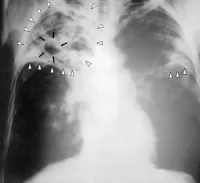1918: Osler describes pneumonia as "captain of the men of death"
In 1918, Sir William Osler, described pneumonia as the "captain of the men of death", because it had overtaken tuberculosis as one of the leading causes of death at the time.
1938: First description of viral pneumonia
In 1938, Hobart Reimann first described viral pneumonia.
1977: Vaccination against Streptococcus pneumoniae in adults begins
In 1977, vaccination against Streptococcus pneumoniae in adults began, resulting in a similar decline in cases.
1988: Vaccination against Haemophilus influenzae type B begins
In 1988, vaccination of infants against Haemophilus influenzae type B began, leading to a dramatic decline in cases shortly thereafter.
2000: Vaccination against Streptococcus pneumoniae in children begins
In 2000, vaccination against Streptococcus pneumoniae in children began, resulting in a similar decline in cases.
2008: Pneumonia cases in children worldwide
In 2008, pneumonia occurred in approximately 156 million children worldwide, with 151 million cases in the developing world and 5 million in the developed world.
2009: Pneumonia is the 8th leading cause of death in the United States
As of 2009, pneumonia is the 8th leading cause of death in the United States.
2009: First World Pneumonia Day
Due to the relatively low awareness of the disease, 12 November was declared in 2009 as the annual World Pneumonia Day.
January 2010: Population-based surveillance begins
From January 2010 through June 2012, a population-based surveillance for community-acquired pneumonia requiring hospitalization was conducted in five hospitals in Chicago and Nashville. 2259 patients were identified with radiographic evidence of pneumonia and specimens that could be tested for the responsible pathogen.
2010: Pneumonia deaths in children worldwide
In 2010, pneumonia resulted in 1.3 million deaths, or 18% of all deaths in those under five years, of which 95% occurred in the developing world.
2011: Pneumonia most common reason for hospital admission in the U.S.
In 2011, pneumonia was the most common reason for admission to the hospital after an emergency department visit in the U.S. for infants and children.
June 2012: Population-based surveillance concludes
From January 2010 through June 2012, a population-based surveillance for community-acquired pneumonia requiring hospitalization was conducted in five hospitals in Chicago and Nashville. 2259 patients were identified with radiographic evidence of pneumonia and specimens that could be tested for the responsible pathogen.
2012: Estimated costs of treating pneumonia in the United States
In 2012 the estimated aggregate costs of treating pneumonia in the United States were $20 billion; the median cost of a single pneumonia-related hospitalization is over $15,000.
2017: Review recommends corticosteroids for severe community acquired pneumonia
A 2017 review recommended the addition of corticosteroids to standard antibiotic treatment for adults with severe community acquired pneumonia to improve outcomes, reducing death and morbidity.
2019: Guideline recommends against general use of corticosteroids
A 2019 guideline recommended against the general use of corticosteroids unless refractory shock was present.
May 2022: FDA recalls Avanos Medical's feeding tube placement system
In May 2022, the FDA recalled Avanos Medical's feeding tube placement system, the CORTRAK* 2 EAS, due to adverse events reported, including pneumonia, which caused a total of 60 injuries and 23 patient deaths.
2023: Vitamin D benefit in children with pneumonia is unclear
As of 2023, the benefit of Vitamin D in children with pneumonia is of unclear benefit.
October 2024: CDC lowers age for adult pneumococcal vaccination
In October 2024, the CDC lowered the age for adult pneumococcal vaccination from 65 to 50 years old to give more adults the opportunity to protect themselves from pneumococcal disease at the age when risk of infection substantially increases.
Mentioned in this timeline
The United States of America is a federal republic located...

Chicago is the most populous city in Illinois and the...

Tuberculosis TB historically known as consumption is a contagious disease...

Vaccination is the process of administering a vaccine to stimulate...

A community is a social unit defined by shared characteristics...
Trending

11 minutes ago Southern California Braces for Intense Storm: Flash Floods, Mudslides, and Tornadoes Possible

12 minutes ago Dariush aims to surpass Oliveira; Saint Denis seeks perfection at UFC 322.
12 minutes ago Xbox Game Pass Adds New Games, Including Pigeon Simulator, in November 2025
12 minutes ago Cathay Pacific Faces Competition to Fiji, Resumes Adelaide Flights with A350.

1 hour ago Pete Alonso's Future: Mets First Base, Red Sox Suitors, and DH Options Explored
1 hour ago Akaash Singh's wife, Jasleen, dragged into online feud by Myron Gaines over podcast confessions.
Popular

Nancy Pelosi is a prominent American politician notably serving as...

Chuck Schumer is the senior United States Senator from New...

Bernie Sanders is a prominent American politician currently serving as...
Nicholas J Fuentes is a far-right political commentator and activist...

Candace Owens is an American political commentator and author known...

XXXTentacion born Jahseh Dwayne Ricardo Onfroy was a controversial yet...